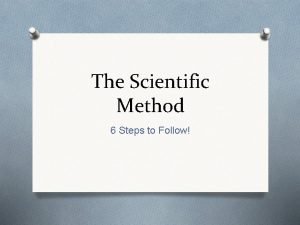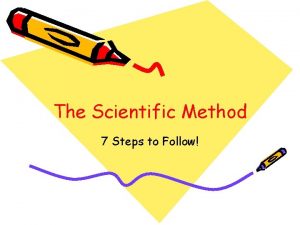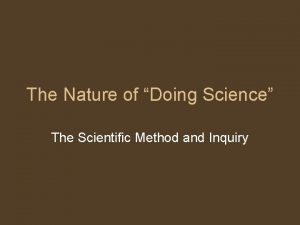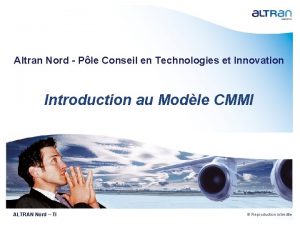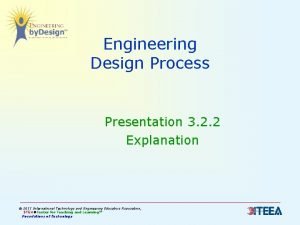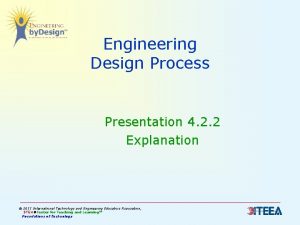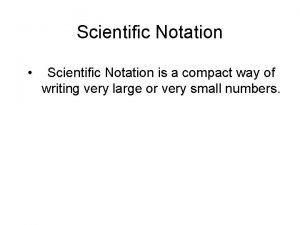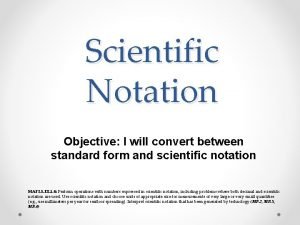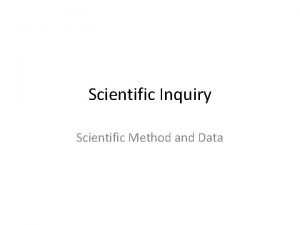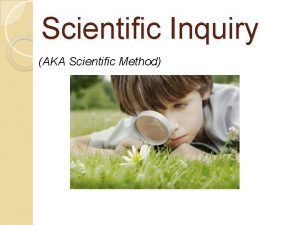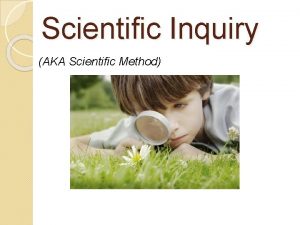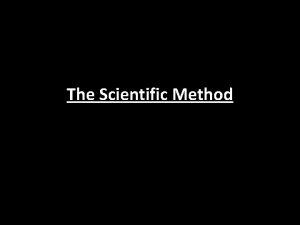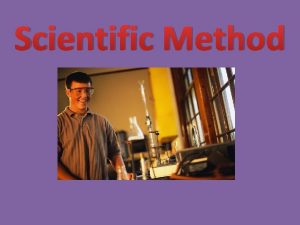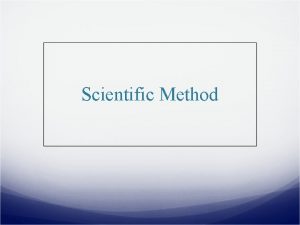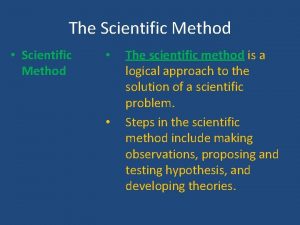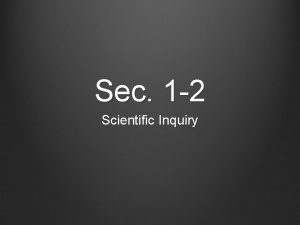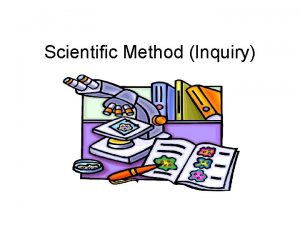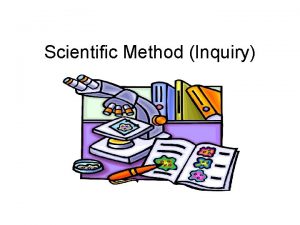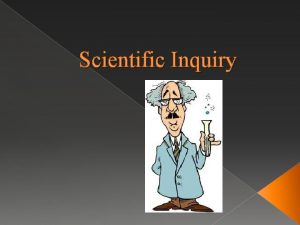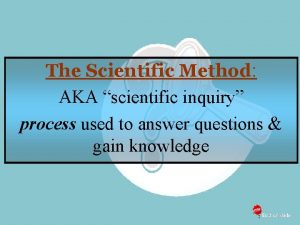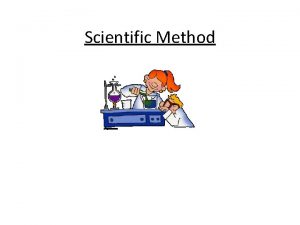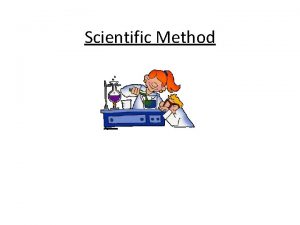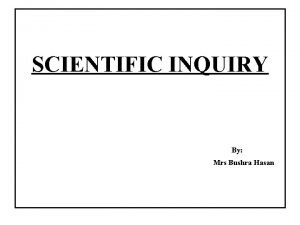Scientific Method The Standard Scientific Inquiry Process The





















- Slides: 21

Scientific Method The Standard Scientific Inquiry Process The approach is orderly. The scientific method is used by all scientists in world independent of cultural backgrounds.

First – A Little Bit of History � Aristotle – Greek philosopher (384 -322 BCE) � Believed in “natural philosophy”, examining the natural phenomena of the world and applying logic and reason to figure things out. Think About It: What are the limitations of this method?

While Europe is in the Dark Ages… � Arab Intellectuals develop a standard method for inquiry based on experimentation (8 – 11 CE) th th

Roger Bacon (1214 – 1294)

Galileo Galilei (1564 -1642) Italian scientist and scholar Galileo made pioneering observations that laid the foundation for modern physics and astronomy. http: //www. biography. com/people/galileo-9305220 • • • Big Rock Star of Science, Argues with the Church Promotes an Inquiry and Experimentation “Cycle” Gets the title “Father of the Scientific Method”

Scientific Inquiry AKA Scientific Method �A formal process used to answer questions. � It is a “tool” that scientists use to find answers to questions. � This process of thinking minimizes the influence of bias or prejudice. � The scientific method leads to higher order thinking skills and scientific literacy.

The 8 -Step Scientific Method � 1 - Make an Observation � 2 - Ask a Scientific/Testable Question � 3 - Do Background Research � 4 - Form a Hypothesis � 5 - Design an Experiment to test the Hypothesis � 6 - Conduct the Experiment � 7 - Analyze Data Collected and Draw a Data. Driven Conclusion � 8 - Communicate Findings and Design Further Experiments.

Step 1 - Make an Observation � Every major and minor scientific advancement starts with the words: �I Wonder…. or I Notice…. .

Step 2 – Ask a Testable Question There are 3 types of Testable Questions � Type 1: Verification Questions � Type 2: Research Questions � Type 3: Investigation Questions ◦ Answers are yes or no ◦ ex. Is the moon full tonight? ◦ Leads to research to get answers ◦ ex. How many full moons in 2014? ◦ Leads to an investigation, includes IV and DV ◦ ex. Are students louder during a full moon? Independent variable (what you change): full moon, no moon Dependent variable (what you measure): students’ loudness � TQs typically start with: How, What, When, Where, If, Is or Do.

Step 3 Do Background Research � Think Critically � Where do you get your information? � Is there conflicting information? � Can conflicting data be explained in terms of bias? � How do you judge whether information is true? � How do you discriminate between objective ( observable, factual) and subjective ( opinion, judgement, assumption, belief, rumor) information?

3 – Conducting Research � Use � Books several different sources : Newspapers magazines

Internet

Step 4 - Stating a Hypothesis � An Educated Prediction about the solution to a problem � A hypothesis does not need to be correct to be useful. An incorrect hypothesis can be revised to form a new hypothesis. � If (IV)…( I do this) then (DV)…( this will …) � Ex - If I raise the temperature of a cup of water, then the amount of sugar that can be dissolved in it will be increased. � Includes the Independent and Dependent Variables(two relating factors)

Step 5 - Design an Experiment � Variables: the things that have effect on the experiment � Dependent Variable – what you are measuring. � Independent Variable – what you are changing to affect the dependent variable. � Controlled Variable – what you keep the same

6 - Conduct the experiment � The purpose of conducting an experiment is to collect data.

Step 7 – Analyze Data Make a conclusion(s) � Summarize the data � Make a data-driven conclusion that answers the testable question. � Try to reference your data � Based on the results…. . , Our data suggests…. � Does the data support or falsify your hypothesis? � State the relationship between the independent and the dependent variables, if any. � Summarize and evaluate your experimental procedure (what was successful/effective) � Suggest possible changes in the experimental procedure or possibilities for further study

Analysis Coming to a Conclusion � Organize your data in one or more of the following methods: � Table Line graph bar graph pie chart

Pictograph Chart

Steps 8 - Communicate Findings and Design Further Experiments � Write up Results and Submit to the World � Can be a journal, blog, stand-alone research paper � Where would you publish your experiment?

When consistency is obtained , the hypothesis becomes a Theory.

https: //www. youtube. com/watch? v=Ur. RUD S 1 xb. Ns&feature=related Google images http: //examples. yourdictionary. com/exampl es-of-hypothesis. html http: //www. asdatoz. com/Documents/Websi te%20 Objective%20 vs%20 subjective%20 ltr. pdf https: //docs. google. com/presentation/d/1 e EK 0 J 4 g 8 XQb. XSTi. Le 2 g. Ftxre 1 Nax. TMIku. Bip. SHt 3 SU/edit#slide=id. g 4 aa 5276 b 3_0242
 Information gathered during an experiment
Information gathered during an experiment List 6 steps of the scientific method
List 6 steps of the scientific method 7 step of scientific method
7 step of scientific method What is scientific inquiry
What is scientific inquiry Nature of scientific inquiry
Nature of scientific inquiry What does gg mean
What does gg mean Altran nord
Altran nord Scientific method vs engineering design process
Scientific method vs engineering design process Scientific method vs engineering design process
Scientific method vs engineering design process Contextual inquiry definition
Contextual inquiry definition Disadvantages of symposium
Disadvantages of symposium Standard error of sampling distribution
Standard error of sampling distribution Home language and standard language
Home language and standard language Define standard cost and standard costing
Define standard cost and standard costing Mata pelajaran dini
Mata pelajaran dini How to do scientific notation
How to do scientific notation 45 700 in scientific notation
45 700 in scientific notation How is a scientific law different from a scientific theory?
How is a scientific law different from a scientific theory? Hát kết hợp bộ gõ cơ thể
Hát kết hợp bộ gõ cơ thể Lp html
Lp html Bổ thể
Bổ thể Tỉ lệ cơ thể trẻ em
Tỉ lệ cơ thể trẻ em

